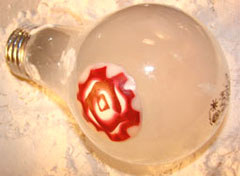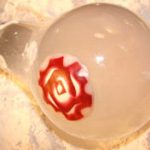
Polymer Clay Techniques | Baking Clay on Alternative Surfaces
There’s Definitely More Than One Way To Bake a Polymer Clay Bead:
More...
There’s Definitely More Than One Way To Bake a Polymer Clay Bead:
When it comes to baking your polymer clay beads and pendants, there are many different “heat-safe” surfaces you can bake on. Getting creative with these baking surfaces can add texture and/or form to your pieces.
For example, in the photo above, you can see a cupped cane slice bead placed on an old incandescent light bulb. The bulb is stabilized on a bed of cornstarch in a container that can be placed into your polymer clay oven or toaster oven for baking.
To see an example of a jewelry pendant made using this unique, light bulb baking technique, click here: Silverware Jewelry Flower Pendant
Other Baking Surfaces To Try Out:
- smooth ceramic tile
- textured ceramic tile
- different light bulb shapes
- glass and metal marbles
- silicone and metal chocolate forms and molds
- textured card stock
- bed of cornstarch
- bed of sand
- ceramic cookie molds
- metal belt buckles
- textured or smooth glass
- upturned bowls, plates, cookware
- heavy drinking glass
- cardboard tubes
- wooden dowels
- terracotta pots turned on their side
- rocks
- bark
- coarse and fine sandpapers
- drywall sandpaper
- drywall mesh tape
- window screen
- wire made into shapes and swirls
- tin cans or any shaped metal
- molded plaster
- rattan place mats
- etc. etc.
Some of the above surfaces may need a release agent such as cornstarch or baby powder in order to prevent the clay from sticking. You should always test on a small scale to be sure.
Also be certain that your surfaces are in fact heat safe BEFORE you bake. Safety is priority one!
Some plastics will be fine at polymer clay baking temperatures, but some will not. Place your baking surface in the oven on a tile by itself and bake for 20 minutes or so, watching carefully to see if it's going to work for you. You don’t want a melted gooey mess in your oven or bad toxic fumes!
Have you ever baked polymer clay on any of the items listed above? Do you have any suggestions to add to the list? Would love to hear from you. Leave a comment below!
Sponsored Ads & Special Promotions


Want to chat about today’s post? That’s what the comment section below is for. Scroll Down… We’d love to hear from you!
Or... if you would like to request a topic for a future post, here is the link to do that… PcT Suggestion Box

I’m having a bit of trouble with my baking surfaces..
Right away to test my oven I used a clay piece on some tin foil. Excited that it cooked without burning, but I realized the foil left a shiny spot.
It was a test, but I can’t get tiles or anything fancy like that. I looked around for some unused baking stuff, I have and found an old metal pan,(not sure if its aluminum or just metal, its black and the other is grey,) a pie pan, and an old rubber silicone muffin mold.
I’m wondering before I go testing if I could use any of these? I’m afraid Paper will burn in the oven, I think I had Parchment Paper but was told that will also burn. I also think glass leaves shiny.
Will the silver pie tray, either metal pans, leave shiny spots? I’m convinced the silicone might work, since you bake muffins in it I’d assume clay would work? But will it stick, or fuse, or burn, or anything like that?
Just want to be extra safe, aha. Sorry for the bother.
I like the ideas above, but I’m just trying to work with what I have at the moment. Thanks~!
Hi Em,
You can bake safely in a glass pan with a sheet of regular office paper in the bottom and a tented piece of paper on the top. (Type ‘tenting’ in the search box at the top of the page for more info.) At the very love temperatures that we bake polymer clay at 265F -275F for Premo Sculpey for example, the paper will not burn as long as it does not touch any of the elements. The nice thing about baking on paper is that you won’t have any shiny spots.
Most all of the answers you need have been answered at one time or another on this blog through the many articles and tutorials, as well as what the other readers share in the comment sections. There are several articles on how to bake polymer clay on this blog, so do make sure to use the search box at the top of the page for more help.
Have fun and thanks for commenting!
Thanks so much, Cindy!
That really helped. And I feel better about baking because I was cooking around 265F and thought it was bad to go under 275.
I’ll be sure to use the search box more & thanks again!
I’m pretty sure Pam that she meant to say she used cornstarch BEFORE baking instead of AFTER. If you rub the clay with cornstarch before baking you can get it nice and smooth, with a matte finish.
You lucky girl to have been at the Bead and Button show. I would love to attend one of those!
Hi Cindy, I went to the Bead and Button Show in Milwaukee, had a blast. Saw a technique that was awesome, wonder if you know how she did it. She had a flat sheet(flowers, leaves..), sliced into a thin oval pendant,earrings, baked on a curved base to make it slightly domed, but the finish was matte, is was incredible, said she did it with cornstarch after baking, any ideas how?? Thanks! Love you’re site! Pam
That’s a good question Joan. I haven’t tried it myself but I can’t imagine it not working as long as the temperature is right. You’ll just have to try it to find out. Let us know how it works. You got me curious!
Cindy,
Here is a question: Can you use a toaster oven to bake poly clay if it is heated with near infra red rays? I bought one at a yard sale cheap but don’t know if there is a big difference between that type of oven and a regular electric one. Thanks!
Joan
I use a Nuwave Infrared oven, and it works great…It also has a fan, so it is a convection oven as well. It is one of those round glass table top ovens. I bought it because I am able to put in a tall objects.
Thank you Lori for the very helpful safety tip!! I really appreciate it. I would hate for anyone or their small animals to be hurt!
Do you know of any particular websites that would have this type of safety info? I would love to post it if you did.
Thanks again!
Please please be careful when selecting items to bake upon. Several materials, wen heated, leach toxic fumes strong enough to kill small animals (I am a biologist – I am not making this up, nor is it one of the internet rumors). I wold suggest running a quinck search on the safety of heating whatever item it is you want to use before I put it in the oven.
Thanks for you helpful tips and ideas!
Lori
Thank you DaisySoapGirl! Happy New Year to you too! It is always a pleasure to have your wonderful, happy self around here!
You’re so smart and creative Cindy. Have a very Happy New Year. I just love your blog and your giving spirit.